Histology of the respiratory system
1/41
There's no tags or description
Looks like no tags are added yet.
Name | Mastery | Learn | Test | Matching | Spaced |
|---|
No study sessions yet.
42 Terms
What is external respiration and where does it occur?
External respiration is the exchange of gases between the lungs and the blood. It occurs in the lungs.
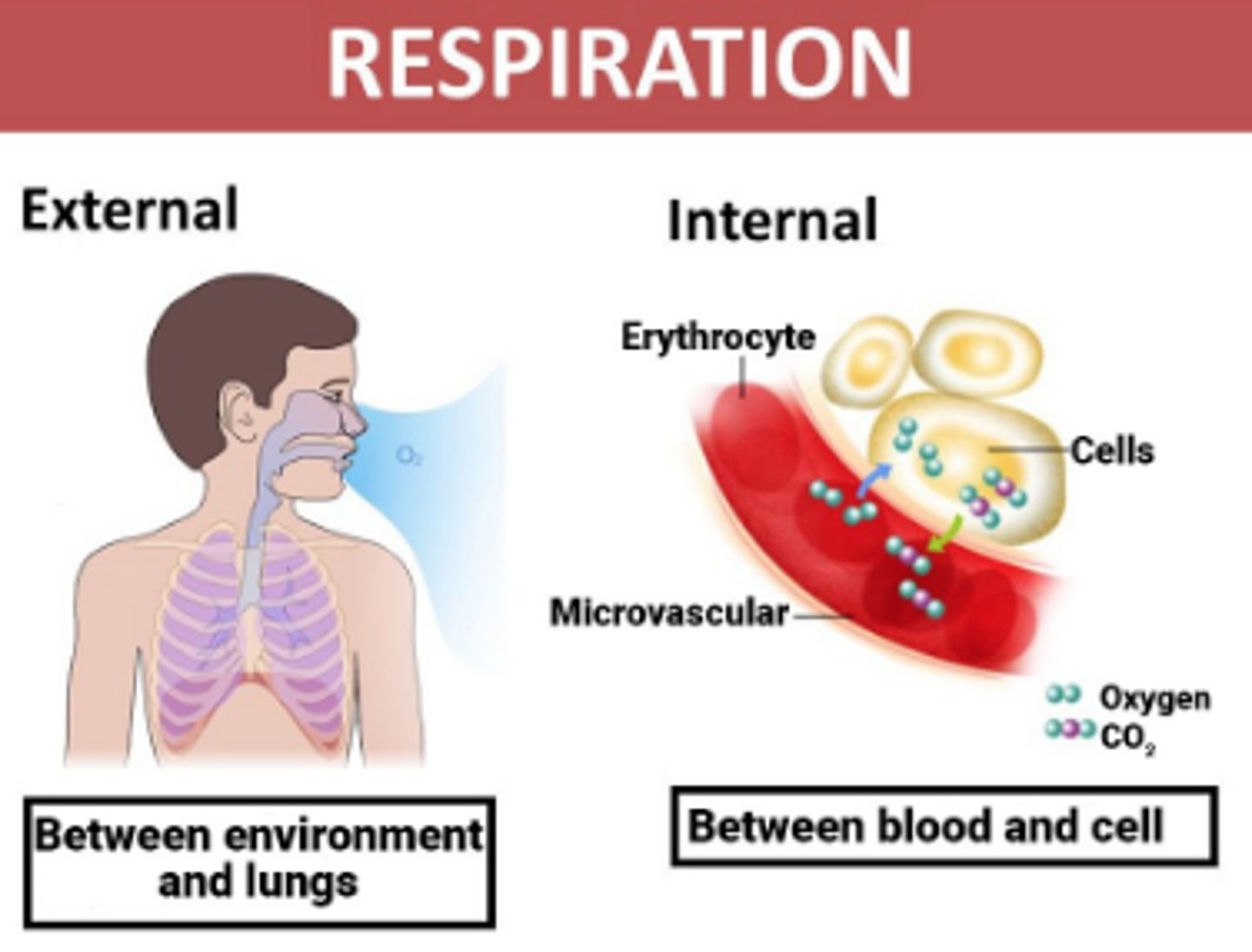
What is internal respiration and where does it occur?
Internal respiration is the exchange of gases between the blood and the body's cells. It occurs in the hemoglobin within red blood cells.
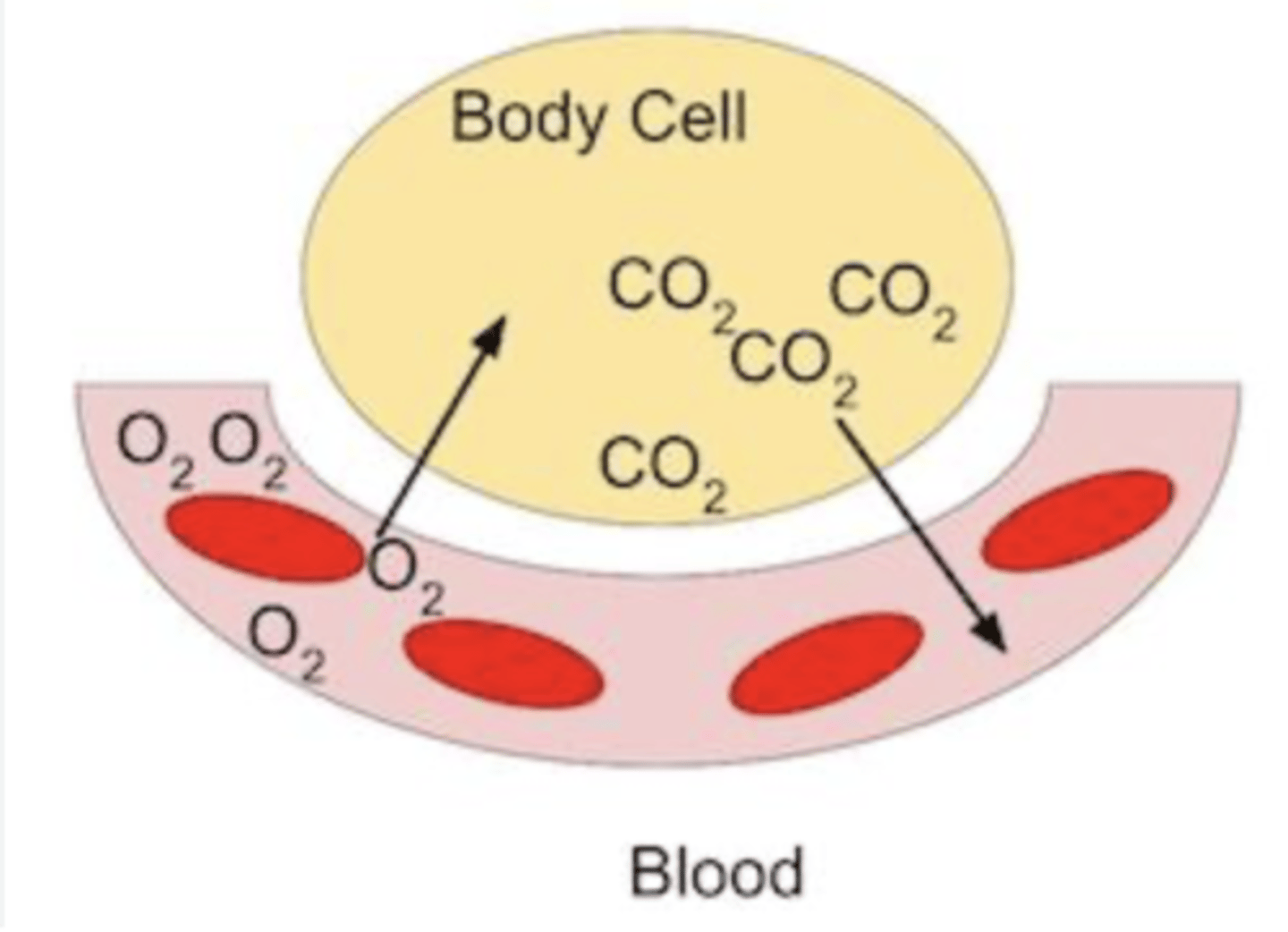
What is the difference between external and internal respiration in terms of gas exchange?
External respiration: involves gas exchange between the lungs and blood (oxygen in, carbon dioxide out)
Internal respiration: involves gas exchange between the blood and body tissues (oxygen out, carbon dioxide in).
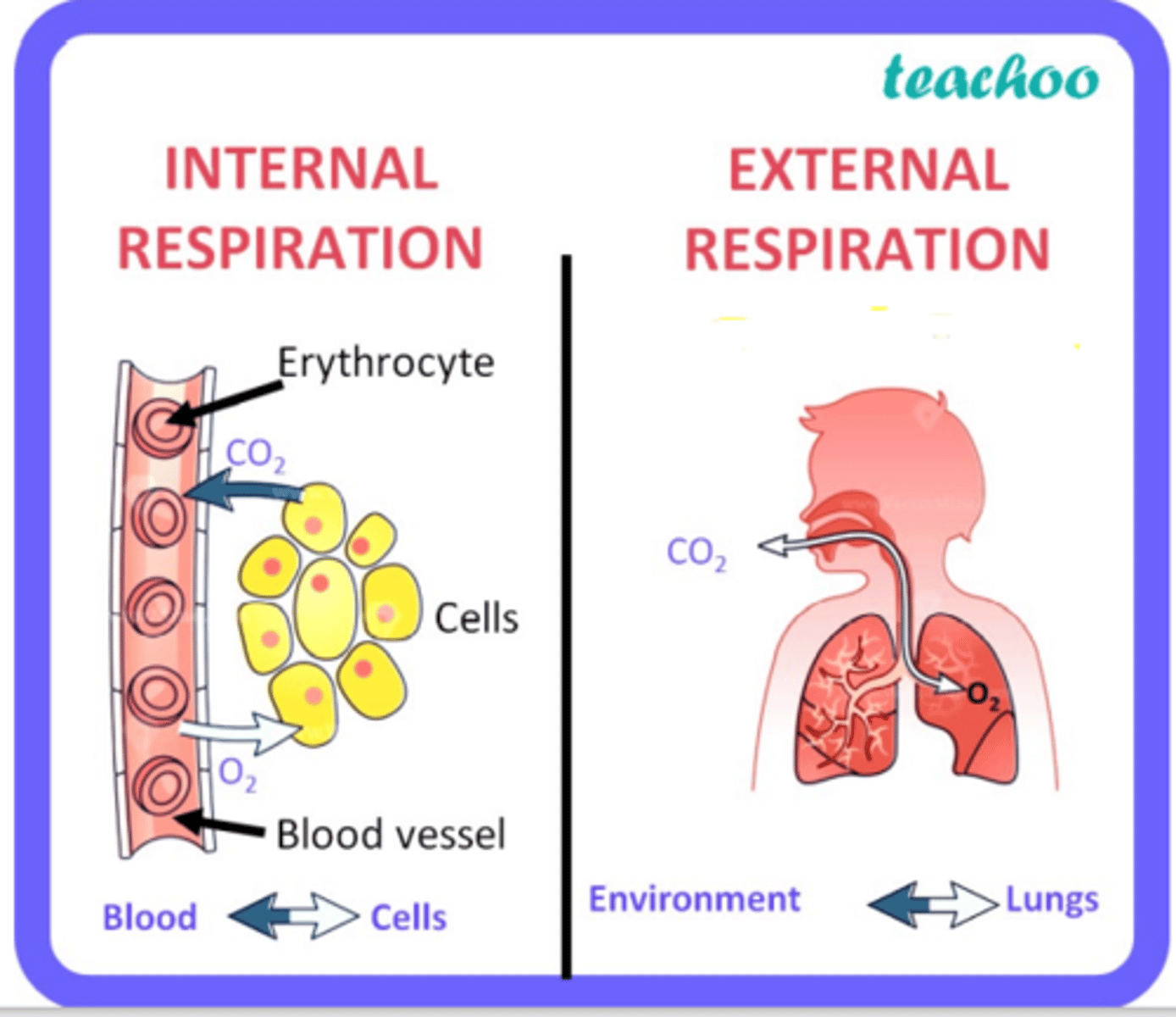
What type of tissue covers the tubes of the respiratory tract?
The respiratory tract is composed of a collection of tubes that facilitate air movement to and from the lungs.
Epithelium covers the tubes of the respiratory tract.
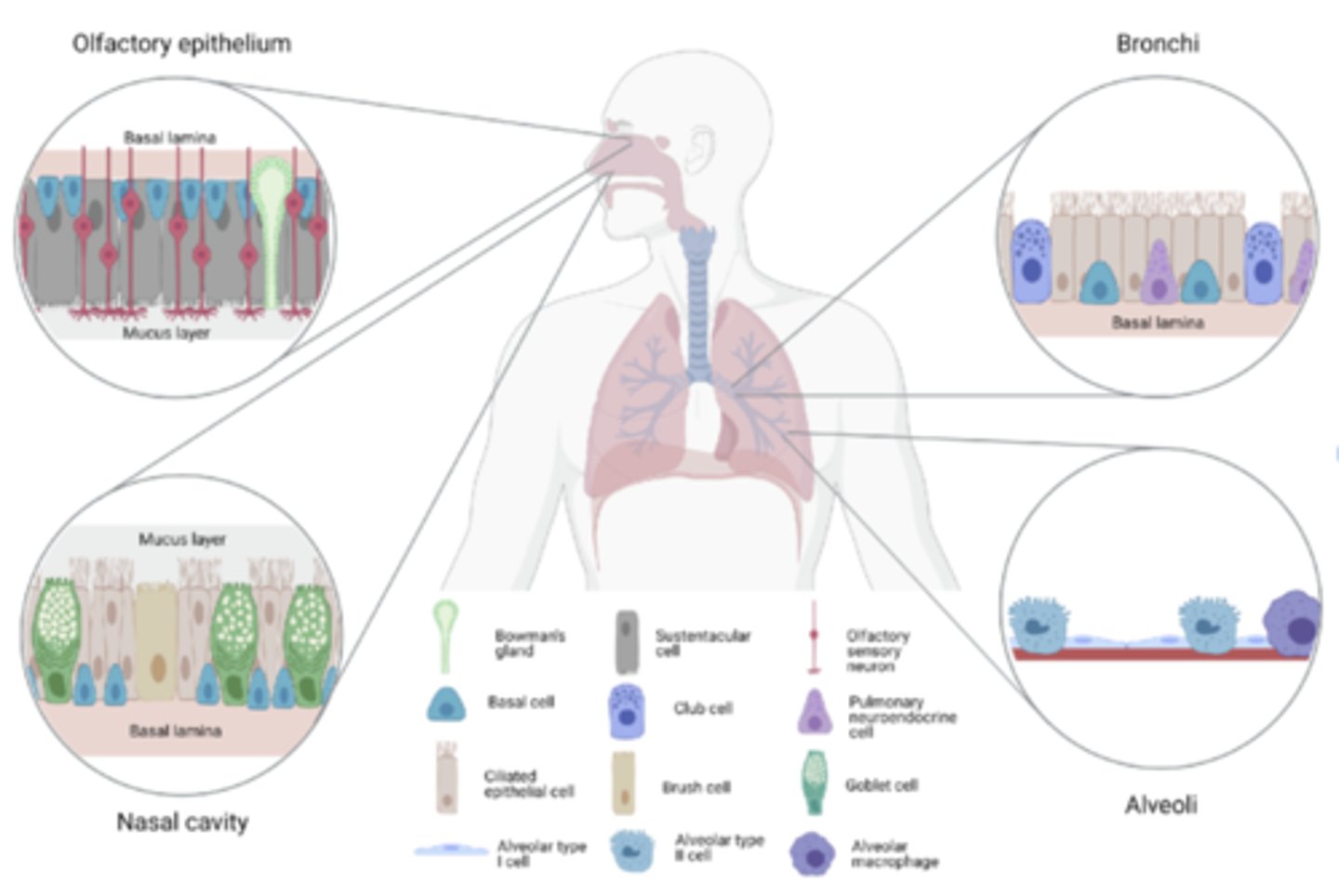
What is the role of the epithelium in the respiratory tract?
The role of the epithelium in the respiratory tract is to protect and line the airways, facilitating efficient gas exchange and defending against pathogens and particles.
The respiratory system is structurally divided into what 2 divisions?
1) Upper respiratory system
2) Lower respiratory system
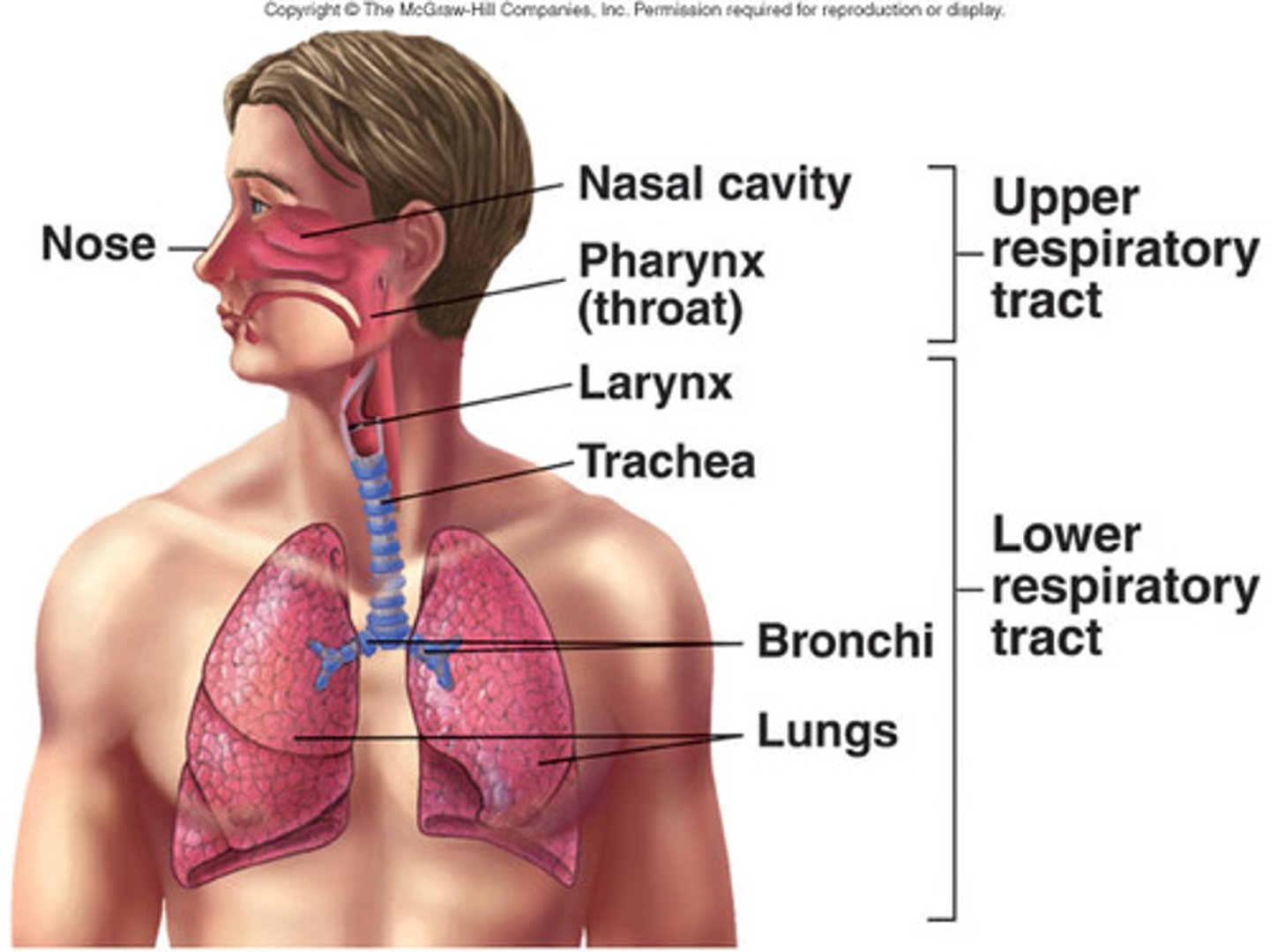
What structures pertain to the upper respiratory system
Nose, pharynx + associated structures

What structures pertain to the lower respiratory system
Larynx, trachea, bronchi and lungs
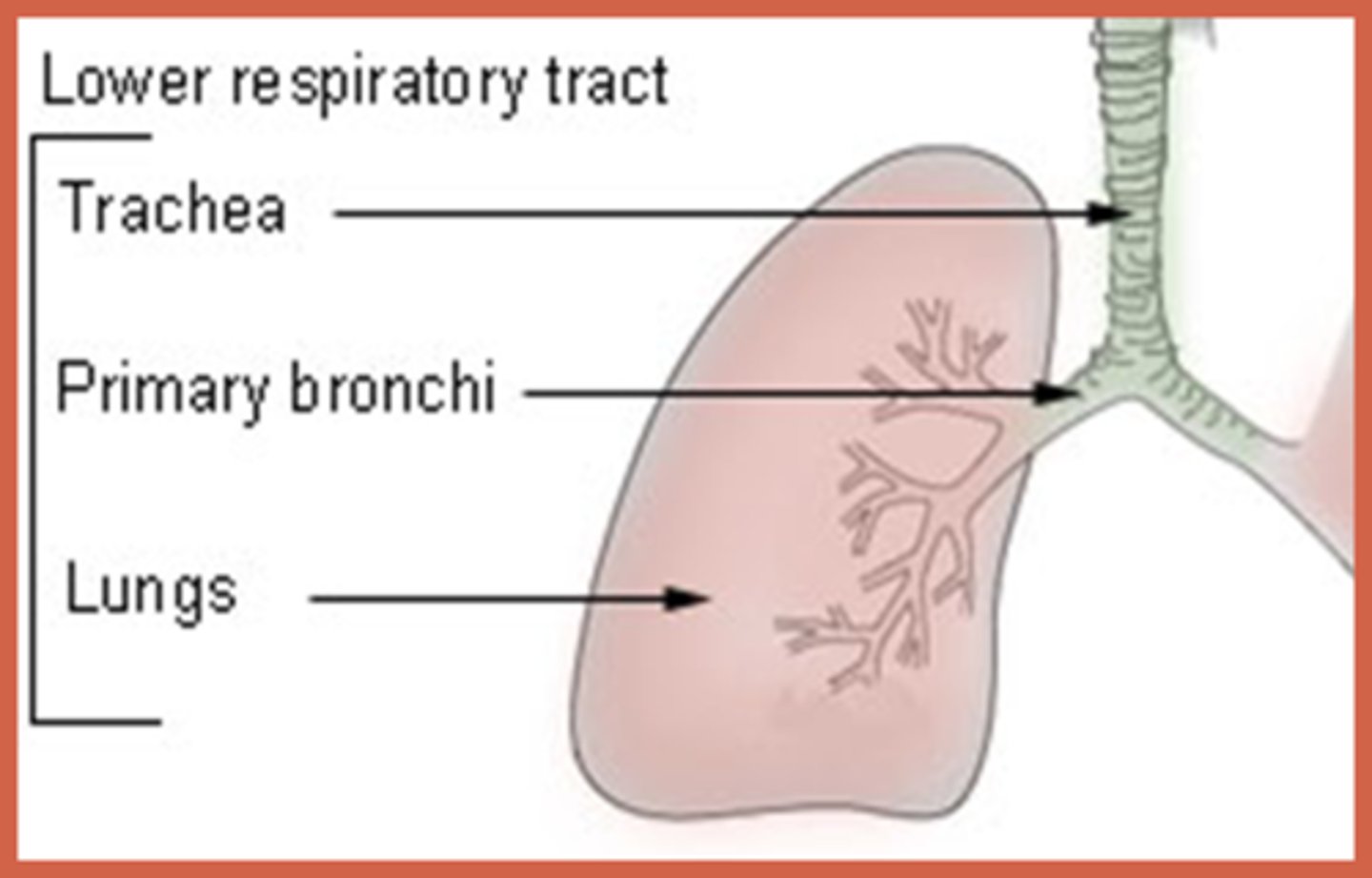
The respiratory system is functionally divided into what 2 divisions?
1) Conducting portion (conducts air to lungs)
2) Respiratory portion (gas exchange)
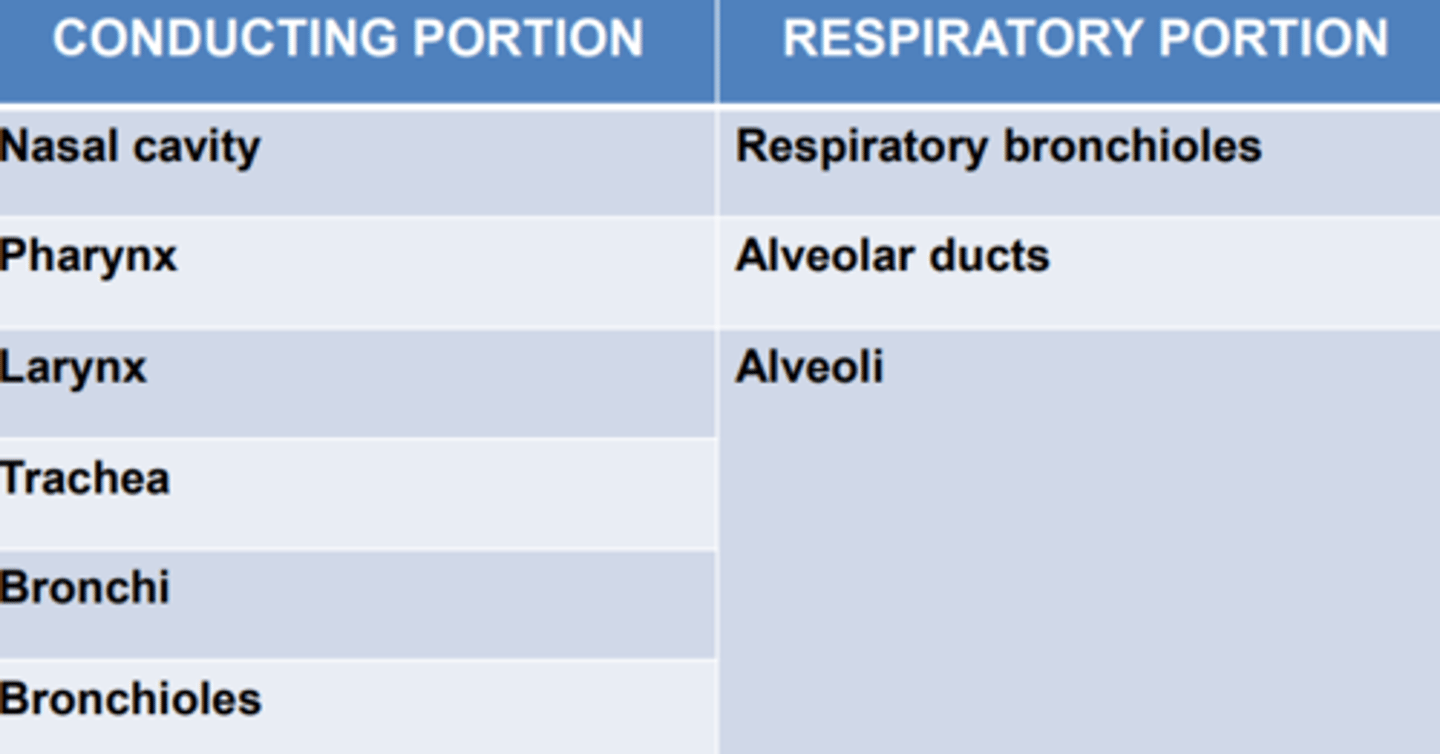
What structures pertain to the conducting portion of the respiratory system
Nose, pharynx, larynx, trachea, bronchi, bronchioles and terminal bronchioles.
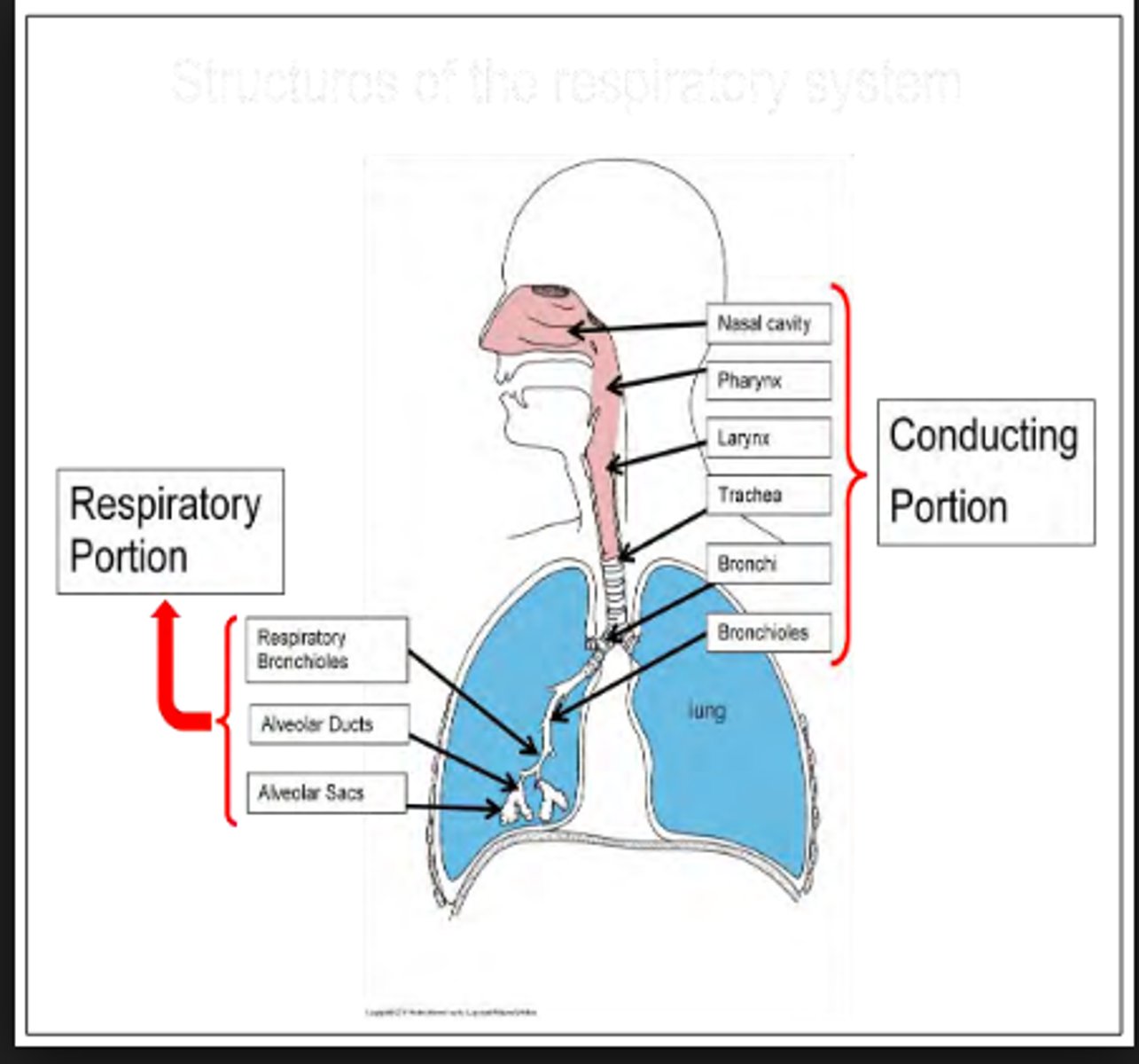
What structures pertain to the respiratory portion of the respiratory system
Respiratory bronchioles, alveolar ducts, alveolar sacs and alveoli.
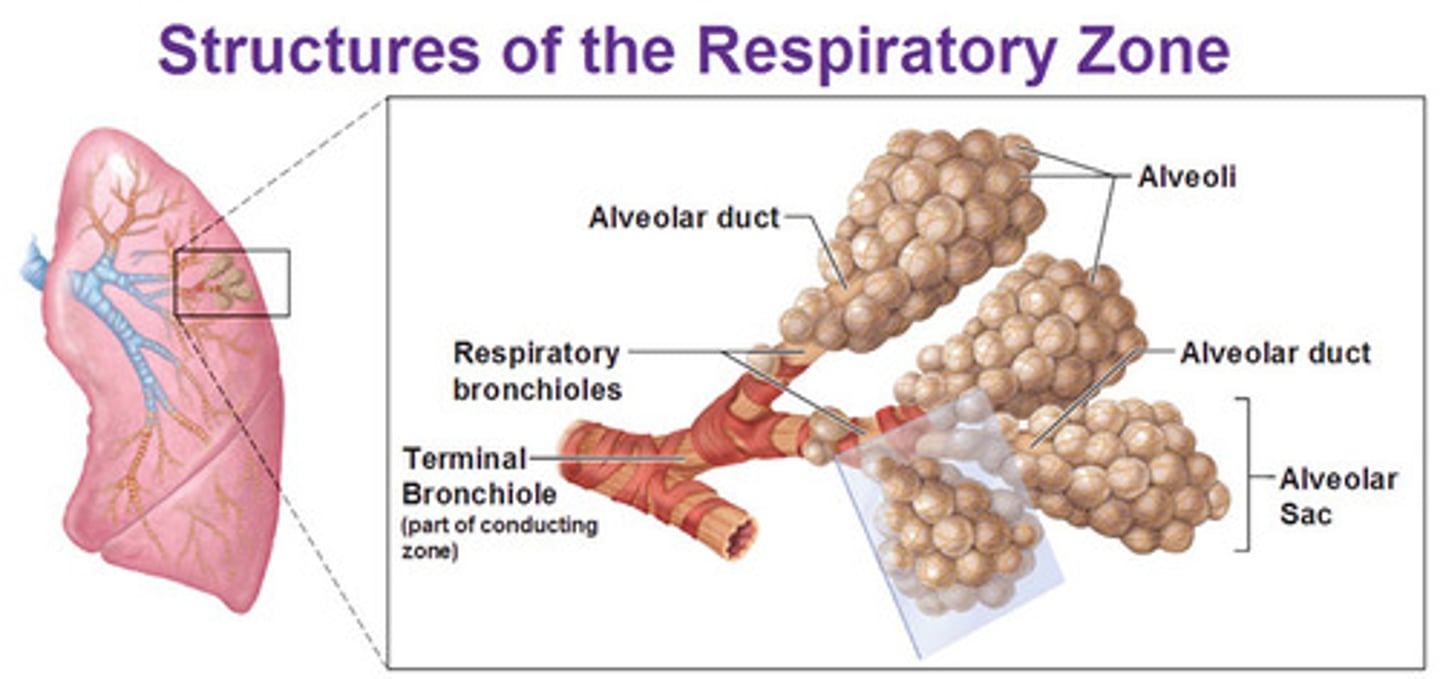
Epithelium recovers all surfaces of the body, and this includes the respiratory tract. List the types of epithelium found in the respiratory tract:
1) Stratified squamous epithelium
2) Olfactory epithelium
3) Respiratory epithelium
What are the two types of stratified squamous epithelium found in the respiratory system?
The two types are keratinized and non-keratinized stratified squamous epithelium.
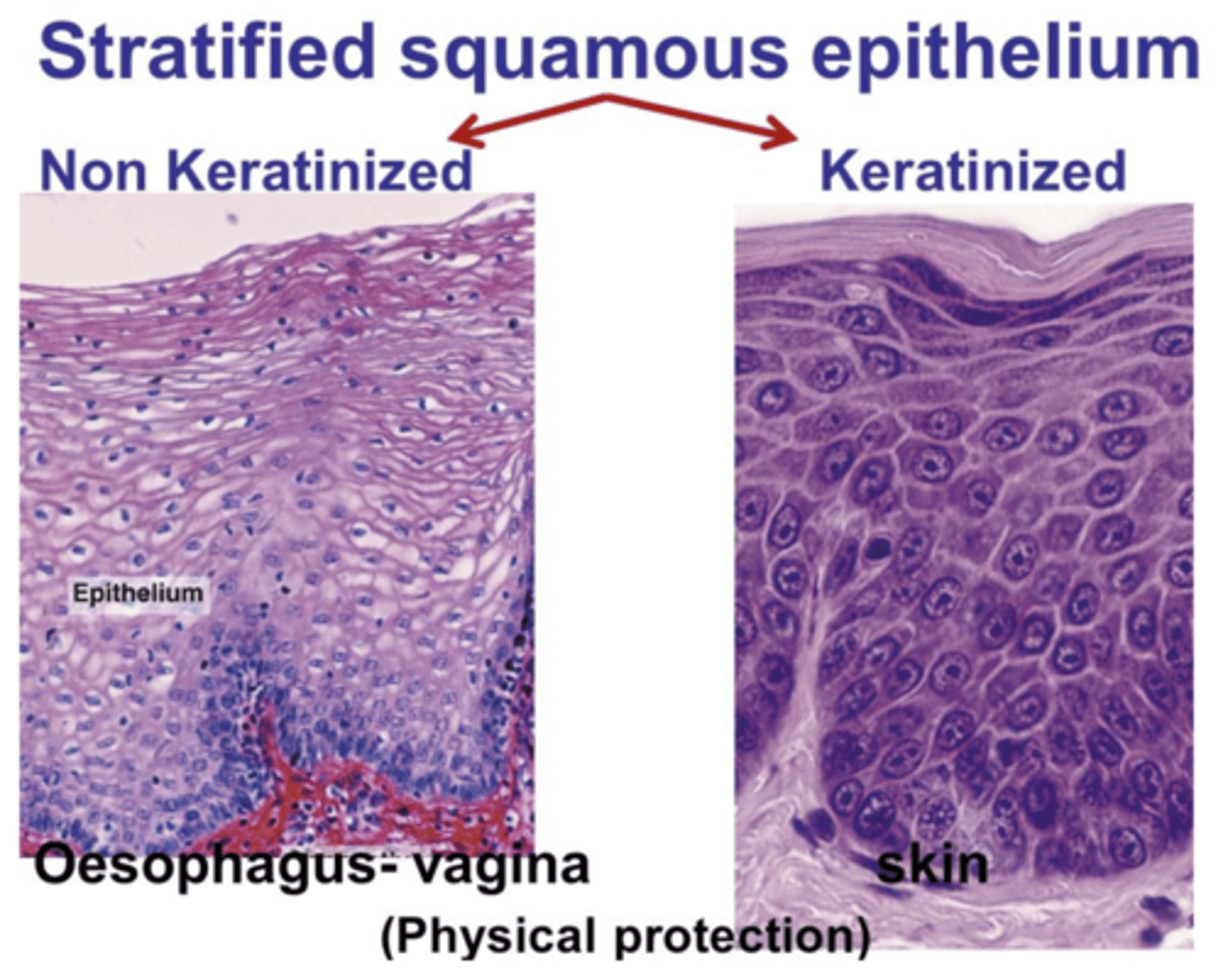
What characterizes respiratory epithelium?
Respiratory epithelium is the general epithelium found along the respiratory tract, involved in air passage and gas exchange.
* NOTE THAT: unlike the olfactory epithelium it does not contain nerves aka: specialized sensory neurons (olfactory receptor cells)
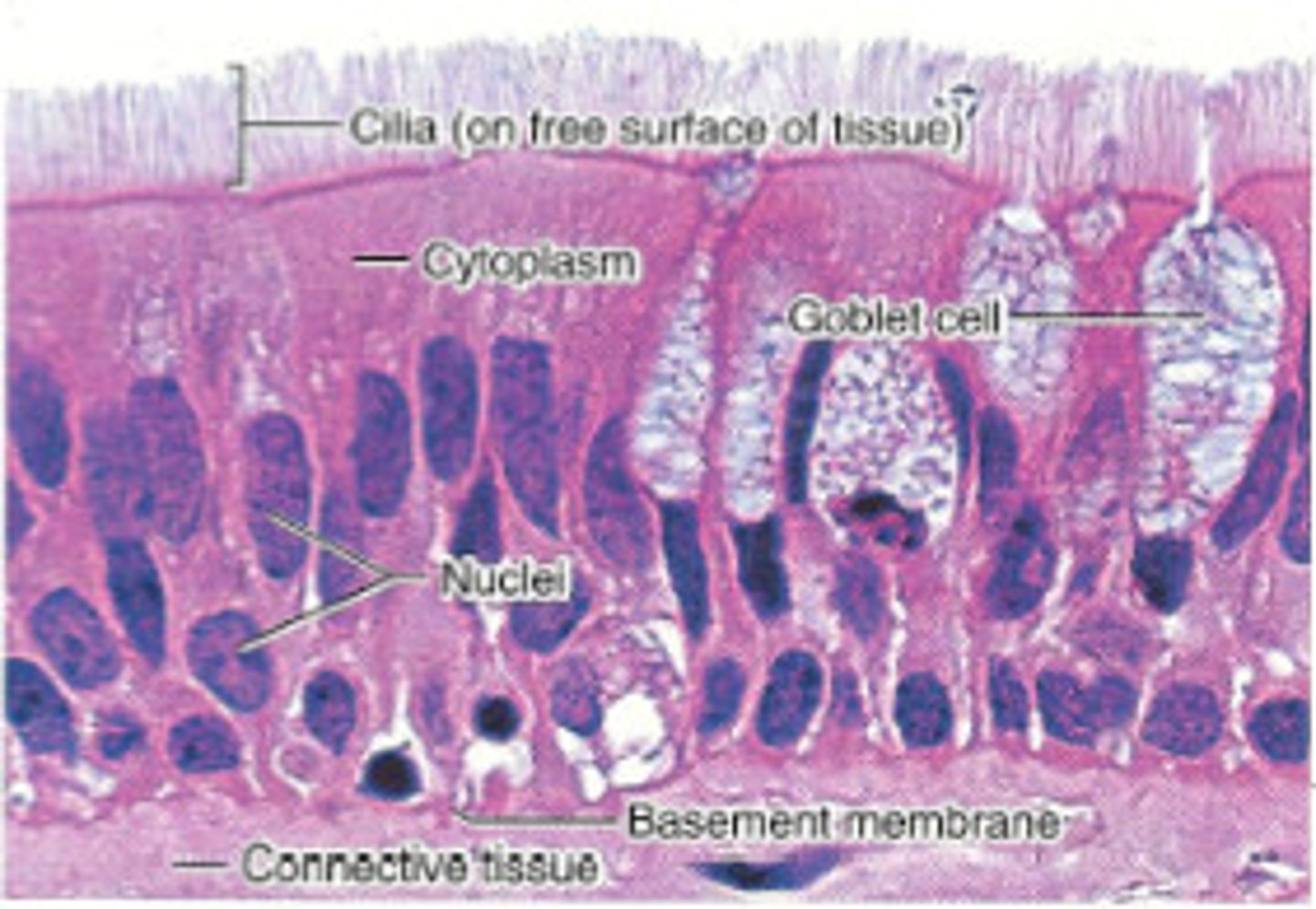
Where is olfactory epithelium found and what does it contain?
Olfactory epithelium is found in the nasal cavity and contains:
1) serous glands
2) nerves
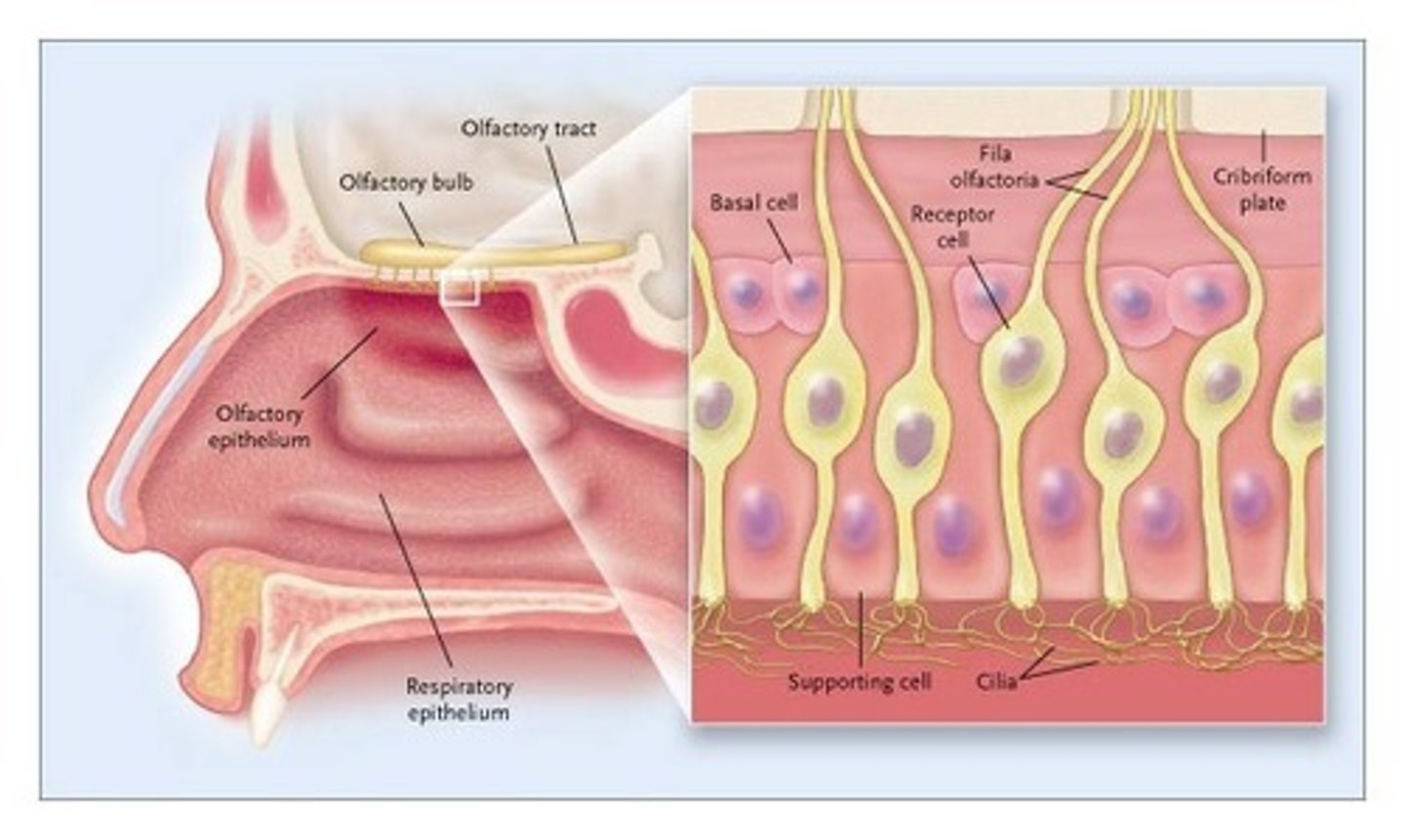
How is olfactory epithelium differentiated from respiratory epithelium?
Olfactory epithelium contains nerves and is involved in smell detection, whereas respiratory epithelium doesn't contain nerves its simply focused on facilitating gas exchange.
When respiratory epithelium contains nerves = olfactory epithelium; when not, it's simply named as respiratory epithelium.
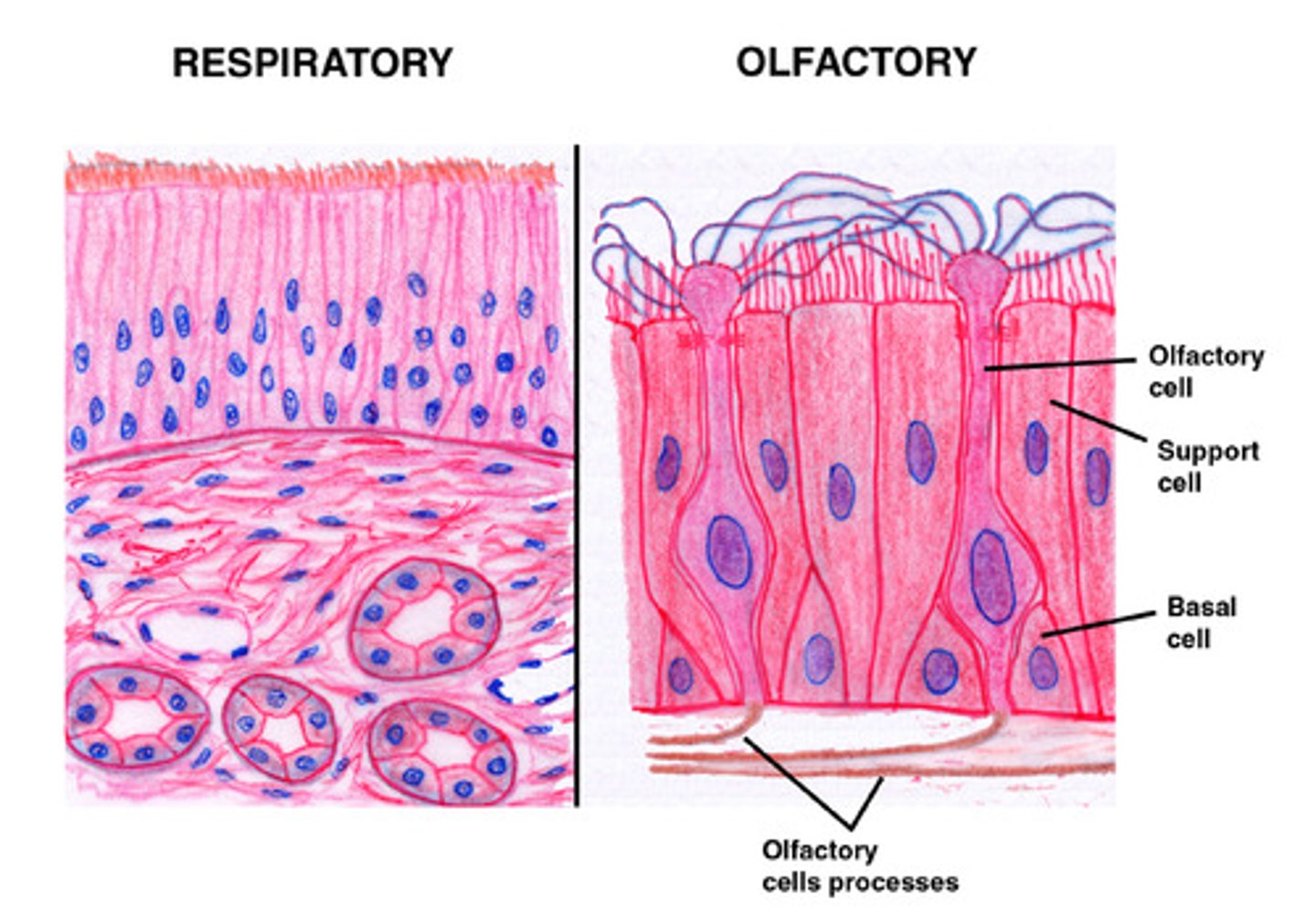
What function does keratinized stratified squamous epithelium serve in the respiratory system?
Keratinized stratified squamous epithelium provides a tough, protective layer against mechanical abrasion and pathogen entry.

How does non-keratinized stratified squamous epithelium differ in function from keratinized?
Non-keratinized stratified squamous epithelium offers protection, flexibility, moisture retention. For areas needing mechanical protection without the harshness of keratinization.
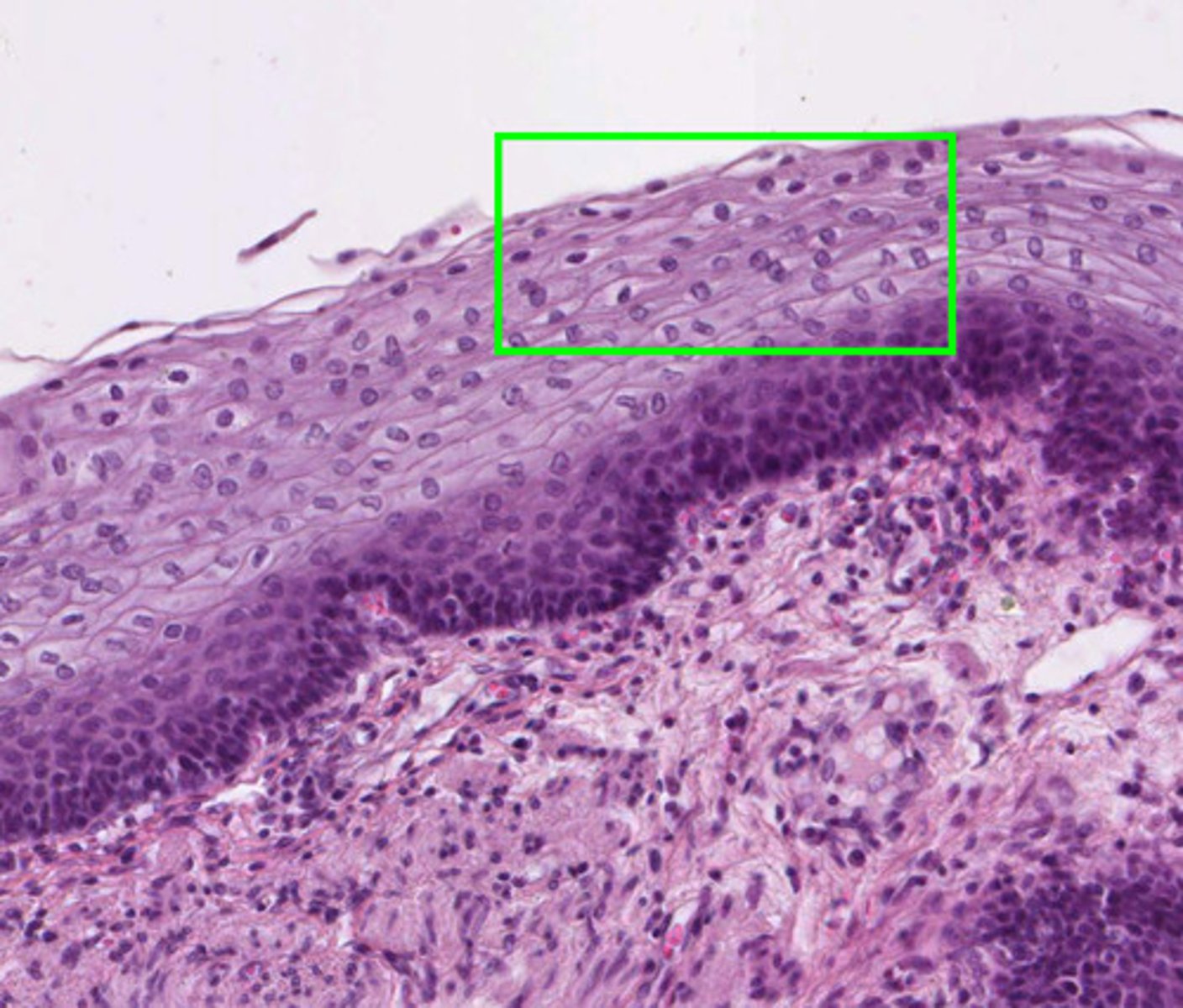
What special functions do the serous glands in the olfactory epithelium perform?
Serous glands in the olfactory epithelium secrete fluids that dissolve odor molecules, facilitating their detection by olfactory receptors.term-19
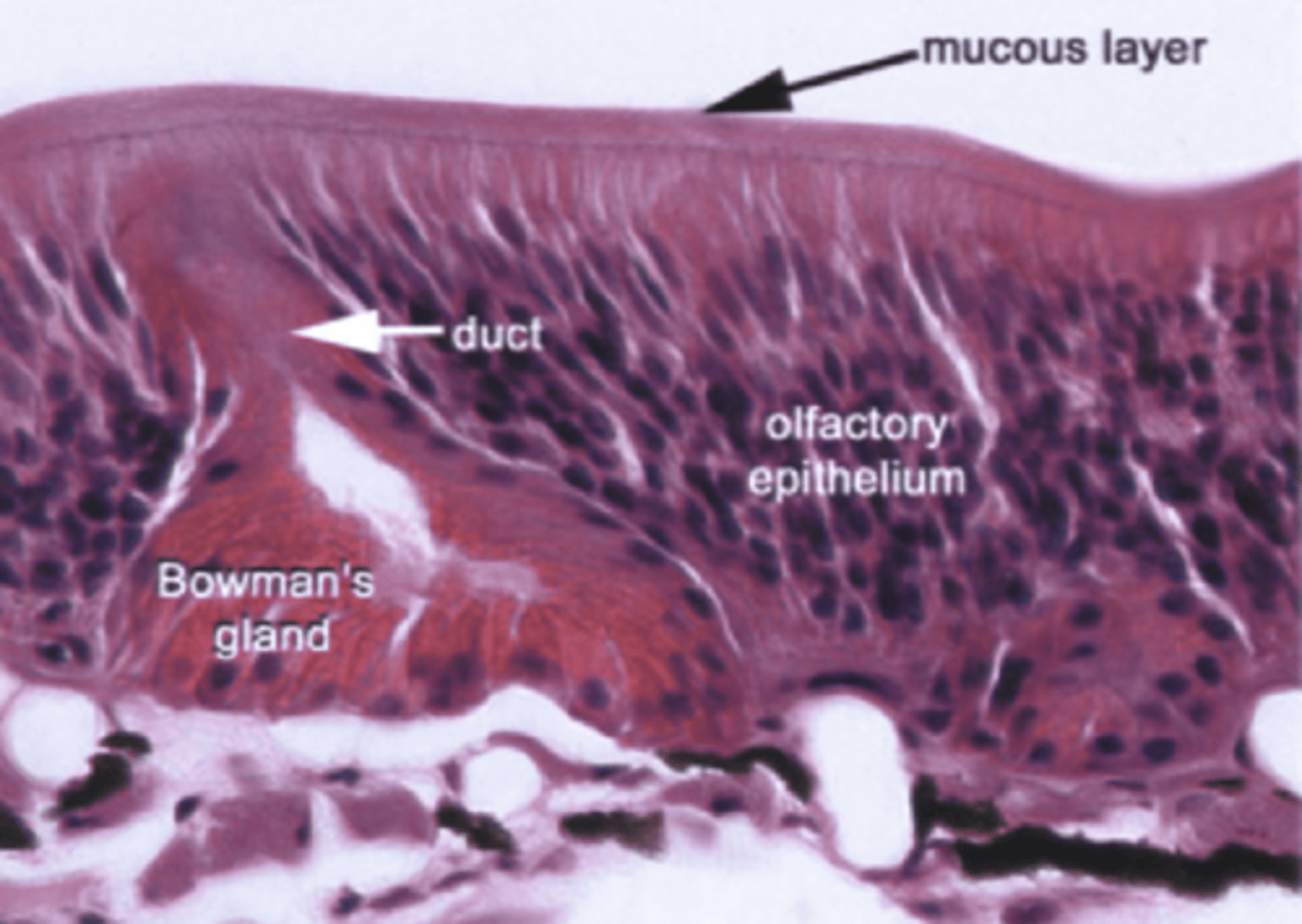
List the types of cells involved in the respiratory epithelium:
Common types:
1) ciliated cells
2) goblet cells
3) basal cells
Less common cell types:
1) Brush cells (sensory receptors)
2) Dense core granule cells
3) Clara cells
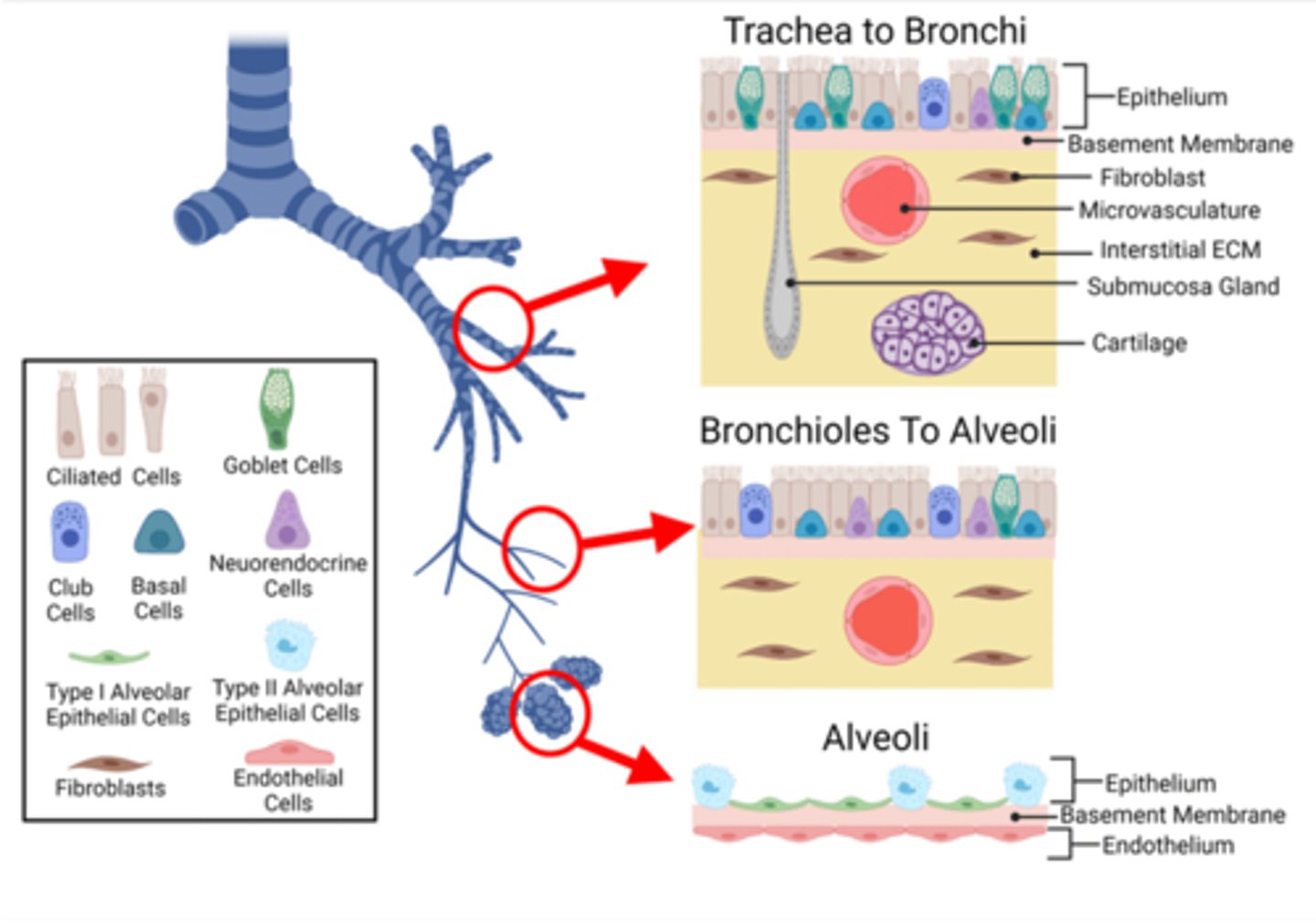
List the common types of epithelial cells in the respiratory epithelium:
1) ciliated cells
2) goblet cells
3) basal cells
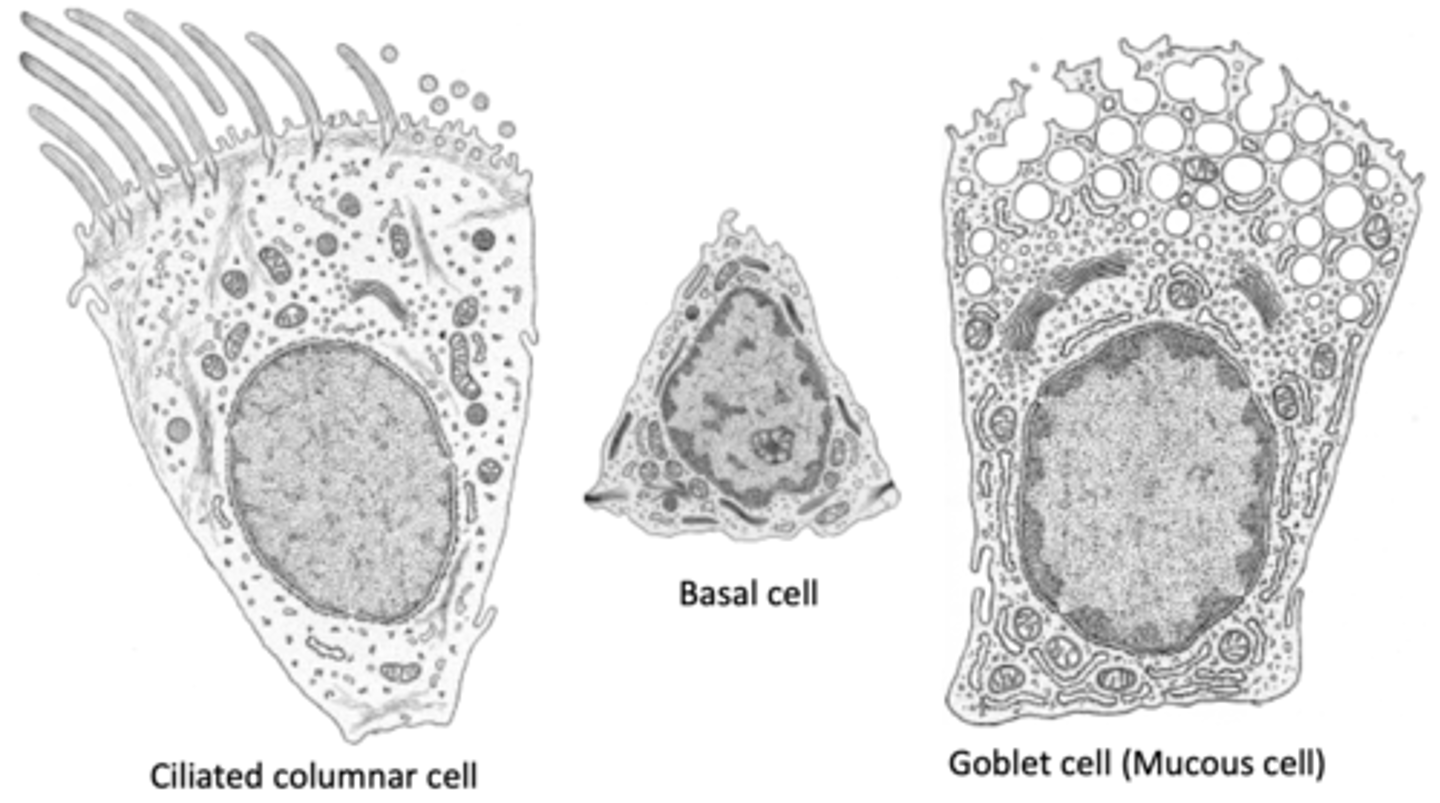
List the less common types of epithelial cells in the respiratory epithelium:
1) Brush cells (sensory receptors)
2) Dense core granule cells
3) Clara cells
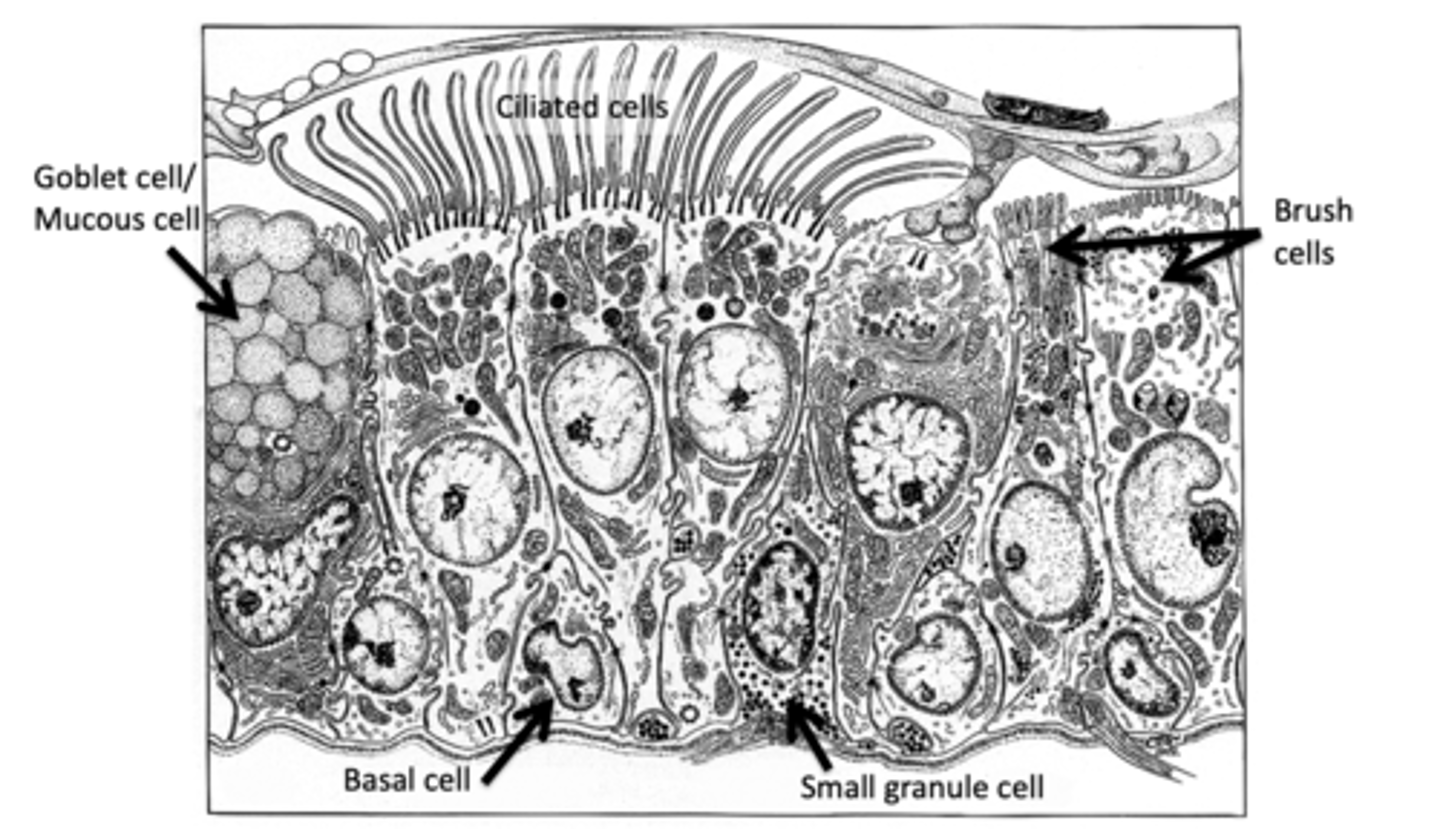
What function do ciliated cells serve in the respiratory epithelium?
Ciliated cells move mucus along the respiratory tract to remove foreign particles and pathogens, aiding in the cleaning and protection of the airways.
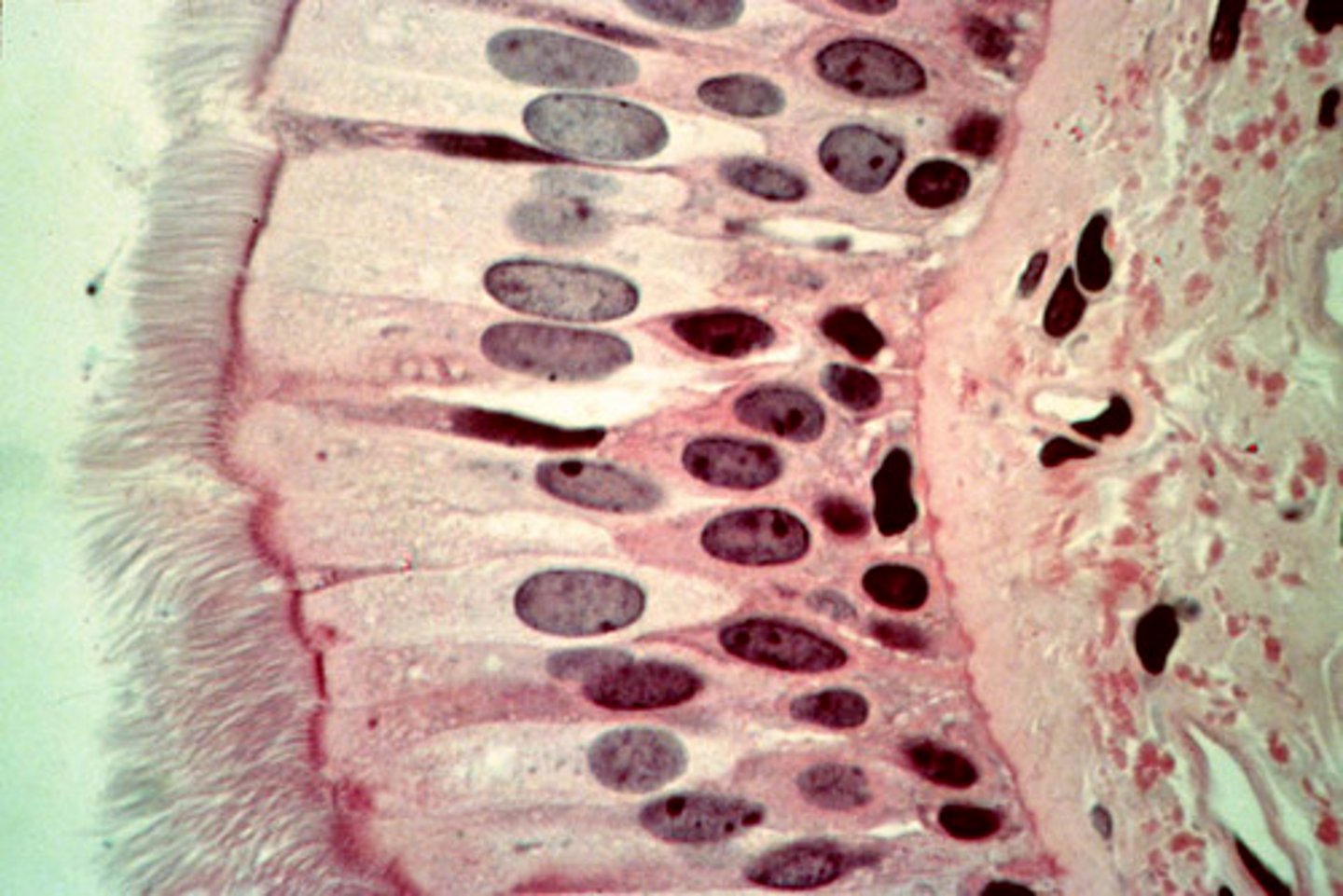
What habit kills ciliated cells?
smoking

What is the primary role of goblet cells in the respiratory epithelium?
Goblet cells secrete mucus, which traps dust, bacteria, and other foreign particles, facilitating their removal from the respiratory tract.
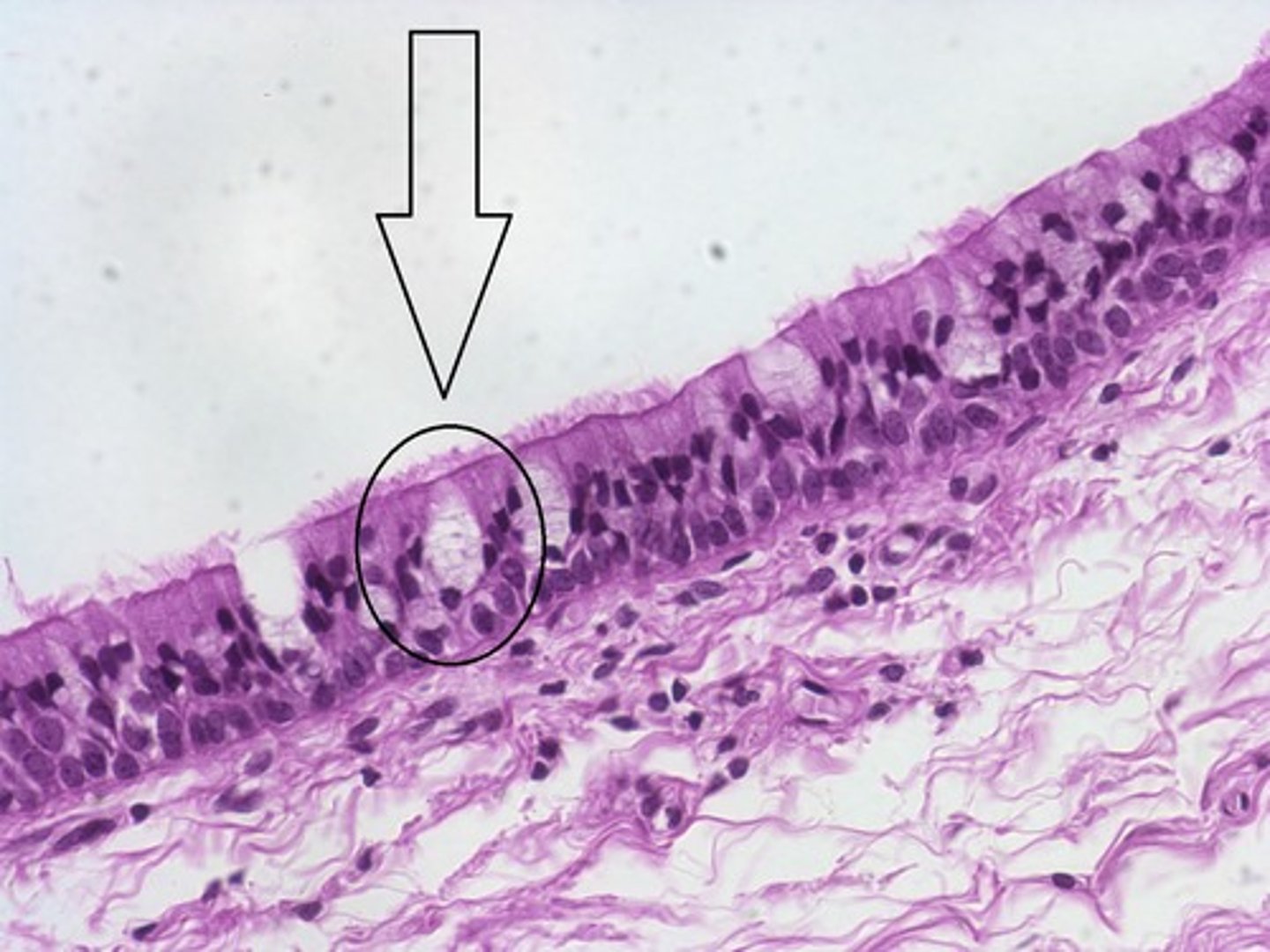
How do basal cells contribute to the respiratory epithelium?
Basal cells are involved in regeneration and repair of upper epithelial cell layers, ensuring epithelium continuity, integrity.
(B- in image)
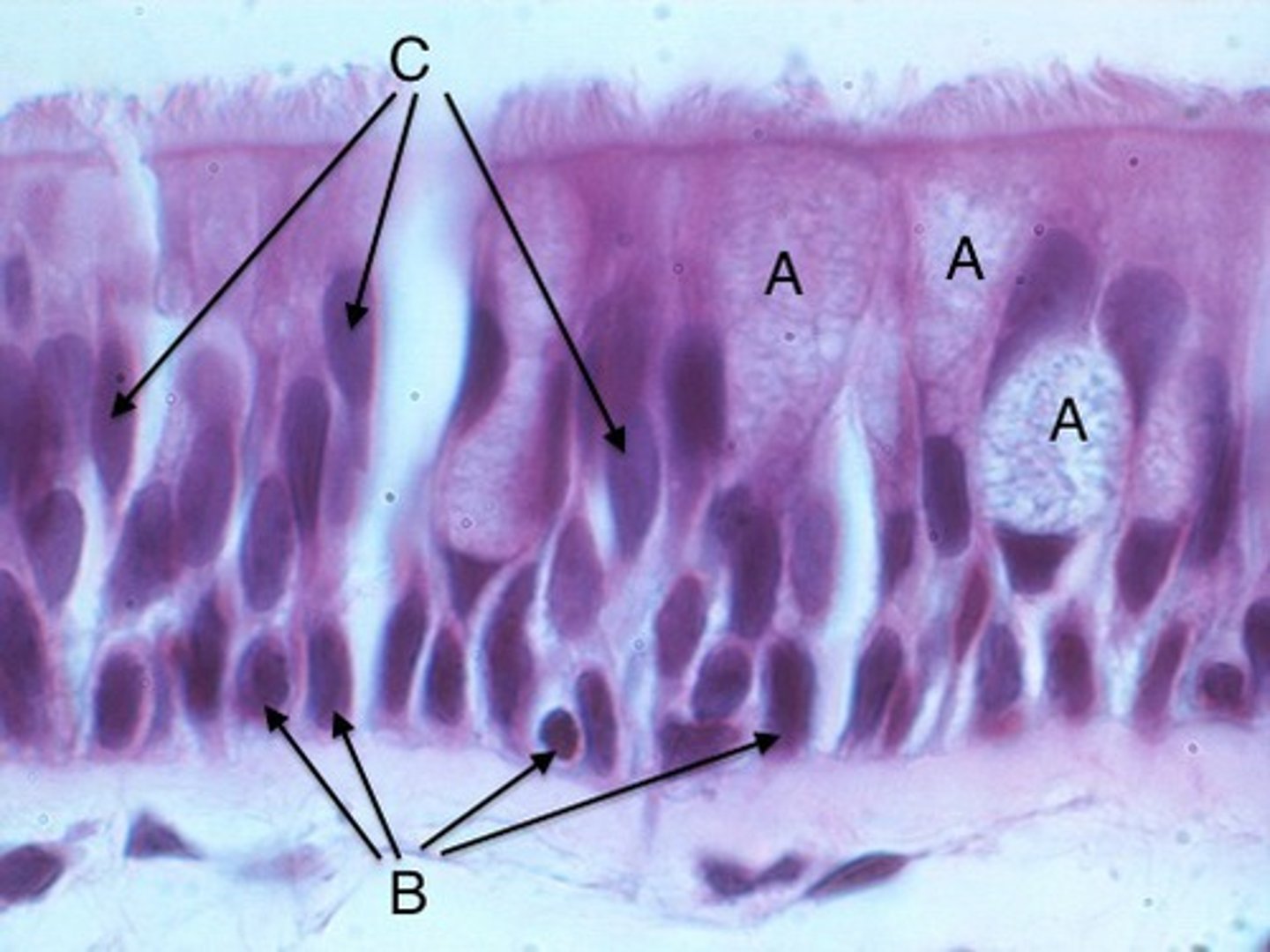
What are brush cells, and what role do they play in the respiratory system?
Brush cells are sensory receptors within the respiratory epithelium, involved in detecting chemical and mechanical stimuli in the airway environment.
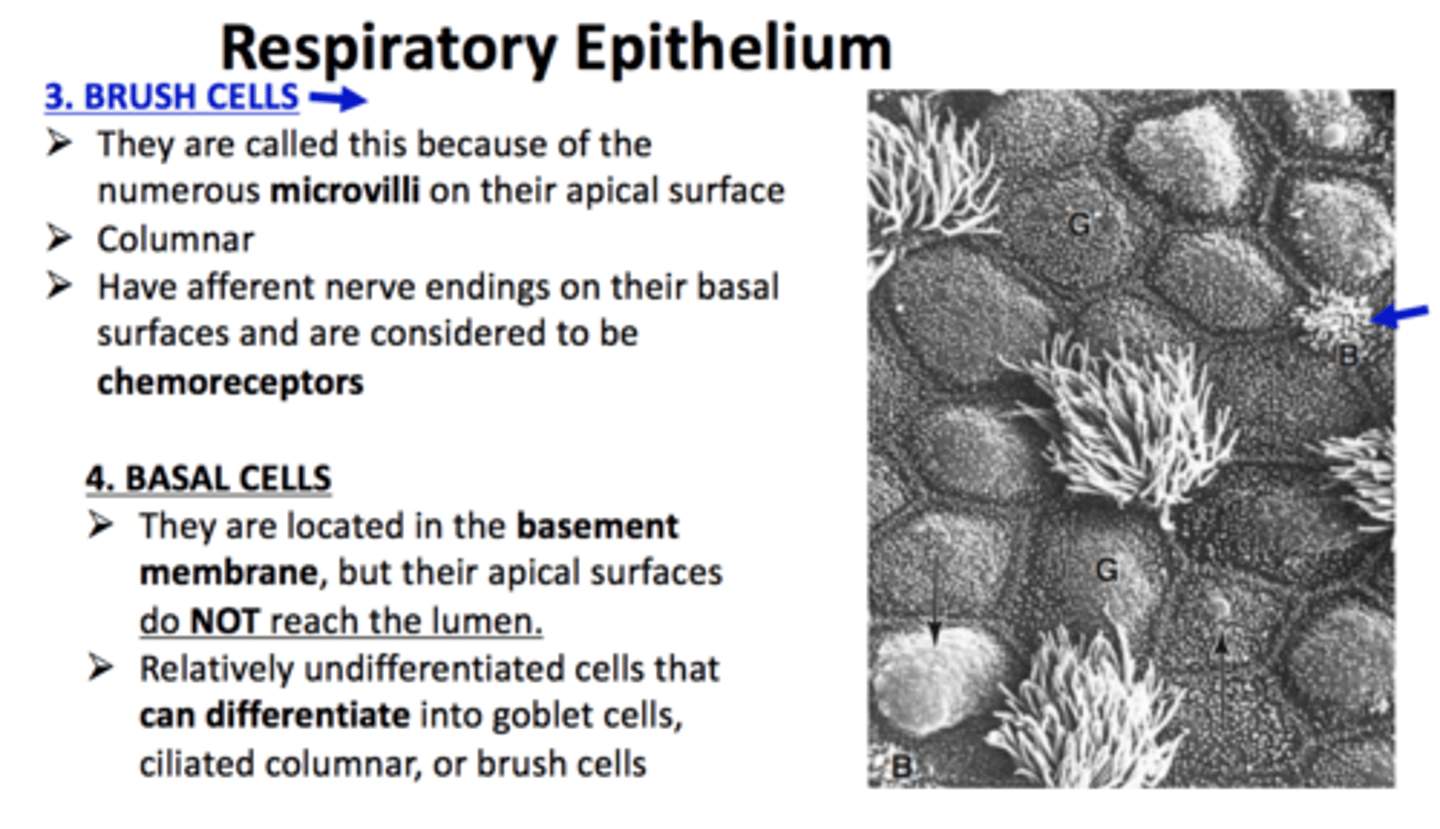
Describe the function of dense core granule cells in the respiratory epithelium.
Dense core granule cells are thought to play a role in local immune responses and signaling within the respiratory tract.
specific functions: less understood
What unique substance do Clara cells secrete, and what is its importance in the respiratory system?
Clara cells secrete surfactant, a fatty substance that reduces surface tension within the airways and alveoli. This surfactant is crucial for keeping airways open, especially those lacking cartilaginous support, and helps prevent alveolar collapse between breaths, facilitating efficient gas exchange.
How does the surfactant produced by Clara cells affect respiratory mechanics?
By lowering the surface tension of pulmonary fluids, surfactant enables easier expansion of the airways and alveoli during inhalation and prevents their collapse during exhalation, significantly improving respiratory efficiency.
What distinguishes Clara cells from other cell types in the respiratory epithelium?
Clara cells are notable for their role in secreting surfactant and their presence mainly in the trachea and bronchi, where they contribute to maintaining open airways and supporting lung function.
Why is the secretion of mucus by goblet cells critical for respiratory health?
Mucus secretion is vital for trapping inhaled pathogens, allergens, and particles, protecting the lung tissue from irritation and infection, and facilitating their removal through ciliary movement.
How does the activity of ciliated cells complement the function of goblet cells?
Ciliated cells propel the mucus secreted by goblet cells towards the throat, where it can be coughed out or swallowed, effectively cleaning the respiratory tract of accumulated debris and pathogens.
What composes the mucosa layer of the respiratory tract?
The mucosa layer consists of respiratory (or olfactory) epithelium and the lamina propria, which is made of loose connective tissue (FECT).
Where are serous glands located in the respiratory tract, and are they always present?
Serous glands may be found in the submucosa layer. They are not always present and may sometimes merge with the lamina propria.
What does the muscularis externa layer comprise in the respiratory system?
The muscularis externa may consist of smooth muscle, cartilage, or bone, depending on the specific location within the respiratory tract.
What is the difference between adventitia and serosa in the respiratory system?
Adventitia is a layer of connective tissue that anchors structures to surrounding tissues, whereas serosa is a similar layer that simply covers the external surfaces. In the nasal cavity, an external serosa layer is found, and adventitia is absent.
Front: What is the function of the lamina propria in the mucosa layer? Back: The lamina propria provides structural support to the epithelium, contains blood vessels and lymphatics for nutrient and waste exchange, and may host immune cells.
Front: How does the composition of the muscularis externa vary in the respiratory tract? Back: The composition of the muscularis externa varies to accommodate the functional needs of different respiratory tract regions, such as allowing for airway constriction or providing rigidity and support.
Front: Why might the submucosa not always contain serous glands? Back: The presence and prominence of serous glands in the submucosa depend on the specific needs for humidification and defense mechanisms in various parts of the respiratory tract.
Front: What type of epithelium is found in the nasal vestibule at the entrance to the nasal cavity? Back: The nasal vestibule is lined with keratinized stratified squamous epithelium, similar to that of the skin.
Front: How does the epithelial lining change as you move from the nasal vestibule into the nasal cavity? Back: As you move from the nasal vestibule into the nasal cavity, the epithelial lining transitions from keratinized stratified squamous epithelium to pseudostratified columnar ciliated epithelium.
Front: What is characteristic of the nasal mucosa posterior to the vestibule? Back: The nasal mucosa posterior to the vestibule is characterized by pseudostratified columnar ciliated epithelium, which is essential for trapping and moving particles out of the nasal cavity.
Front: Why does the nasal cavity feature a transition from keratinized to pseudostratified columnar ciliated epithelium? Back: This transitio
Front: How does the external serosa layer contribute to the nasal cavity's function? Back: The external serosa layer in the nasal cavity provides a protective covering, helping to maintain a controlled environment for air to be conditioned before reaching deeper parts of the respiratory system.
These flashcards cover the general organizational pattern of the respiratory system, detailing each layer's structure, components, and functions.